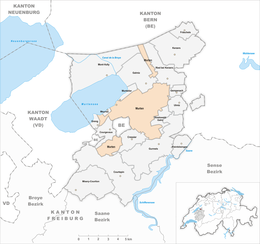Murten
| (English) (French) Morat (German) Murten |
||
|---|---|---|
 |
||
|
||
| Coordinates: 46°55′N 7°07′E / 46.917°N 7.117°ECoordinates: 46°55′N 7°07′E / 46.917°N 7.117°E | ||
| Country | Switzerland | |
| Canton | Fribourg | |
| District | See | |
| Government | ||
| • Executive |
Gemeinderat / Conseil communal with 8 members |
|
| • Mayor |
Stadtammann / Syndic (list) Christian Brechbühl FDP/PRD (as of March 2014) |
|
| • Parliament |
Generalrat / Conseil général with 50 members |
|
| Area | ||
| • Total | 17.41 km2 (6.72 sq mi) | |
| Elevation | 453 m (1,486 ft) | |
| Population (Dec 2015) | ||
| • Total | 8,120 | |
| • Density | 470/km2 (1,200/sq mi) | |
| Postal code | 3280 | |
| SFOS number | 2275 | |
| Surrounded by | Bas-Vully, Büchslen, Courgevaux, Galmiz, Greng, Haut-Vully, Lurtigen, Meyriez, Münchenwiler (BE), Muntelier, Müntschemier (BE), Ried bei Kerzers, Salvenach | |
| Website |
www SFSO statistics |
|
Murten (German) or Morat (French) is a municipality in the See district of the canton of Fribourg in Switzerland.
It is located on the southern shores of Lake Morat, also commonly called Lake Murten. Morat is situated between Berne and Lausanne and is the capital of the See/Lac District of the canton of Fribourg. It is one of the municipalities with a majority (about 75%) of German speakers in the predominantly French-speaking Canton of Fribourg.
On 1 January 1975 the former municipality of Burg bei Murten merged into the municipality of Murten. It was followed on 1 January 1991 by the former municipality of Altavilla and on 1 January 2013 by the former municipality of Büchslen. On 1 January 2016 the former municipalities of Courlevon, Jeuss, Lurtigen and Salvenach merged into Morat(Murten).
The oldest archaeological traces of a settlement around Morat are from the Mesolithic (8200-5500 BC). The Mesolithic finds are mostly small flint shards for use in weapons or tools. These flints were produced mostly in the swampy lowlands east of the city at Murten-Combette and Murten-Ober Prehl. While many of these flint objects are in museums, the exact discovery sites were not properly documented and have been lost or covered by later excavations. Several other sites were discovered during construction of the A1 motorway in 1976-95. These settlements are from the Neolithic (5500-2500 BC) and the Bronze Age (2300-800 BC). Murten Pré de la Blanc was used in the Neolithic and middle Bronze Age, while the sites Murten-Lowenberg, Murten-Ober Prehl and Chantemerle 1 are from the Late Bronze Age. The cemetery at Lowenberg was used for more than a millennium, from the middle Bronze Age to the La Tène period. The nearby necropolis holds a number of Hallstatt era graves. The remains of a large Roman villa from the end of 1st or early 2nd century BC and a piece of a Roman road have also been found.
...
Wikipedia



